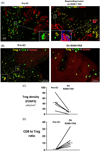Outcomes on anti-VEGFR-2/paclitaxel treatment after progression on immune checkpoint inhibition in patients with metastatic gastroesophageal adenocarcinoma
- PMID: 33739449
- PMCID: PMC8488901
- DOI: 10.1002/ijc.33559
Outcomes on anti-VEGFR-2/paclitaxel treatment after progression on immune checkpoint inhibition in patients with metastatic gastroesophageal adenocarcinoma
Abstract
Through our involvement in KEYNOTE-059, we unexpectedly observed durable responses in two patients with metastatic gastroesophageal adenocarcinoma (mGEA) who received ramucirumab (anti-VEGFR-2)/paclitaxel after immune checkpoint inhibition (ICI). To assess the reproducibility of this observation, we piloted an approach to administer ramucirumab/paclitaxel after ICI in more patients, and explored changes in the immune microenvironment. Nineteen consecutive patients with mGEA received ICI followed by ramucirumab/paclitaxel. Most (95%) did not respond to ICI, yet after irRECIST-defined progression on ICI, all patients experienced tumor size reduction on ramucirumab/paclitaxel. The objective response rate (ORR) and progression-free survival (PFS) on ramucirumab/paclitaxel after ICI were higher than on the last chemotherapy before ICI in the same group of patients (ORR, 58.8% vs 11.8%; PFS 12.2 vs 3.0 months; respectively). Paired tumor biopsies examined by imaging mass cytometry showed a median 5.5-fold (range 4-121) lower frequency of immunosuppressive forkhead box P3+ regulatory T cells with relatively preserved CD8+ T cells, post-treatment versus pre-treatment (n = 5 pairs). We then compared the outcomes of these 19 patients with a separate group who received ramucirumab/paclitaxel without preceding ICI (n = 68). Median overall survival on ramucirumab/paclitaxel was longer with (vs without) immediately preceding ICI (14.8 vs 7.4 months) including after multivariate analysis, as was PFS. In our small clinical series, outcomes appeared improved on anti-VEGFR-2/paclitaxel treatment when preceded by ICI, in association with alterations in the immune microenvironment. However, further investigation is needed to determine the generalizability of these data. Prospective clinical trials to evaluate sequential treatment with ICI followed by anti-VEGF(R)/taxane are underway.
Keywords: anti-VEGFR2; gastric/gastroesophageal cancers; immune checkpoint inhibition; paclitaxel; tumor microenvironment.
© 2021 Union for International Cancer Control.
Figures


Similar articles
-
Real-world ramucirumab and immune checkpoint inhibitor sequences in US patients with advanced gastroesophageal cancer.Future Oncol. 2023 Jun;19(18):1277-1291. doi: 10.2217/fon-2022-0604. Epub 2023 May 17. Future Oncol. 2023. PMID: 37194743
-
Targeting VEGFR2 with Ramucirumab strongly impacts effector/ activated regulatory T cells and CD8+ T cells in the tumor microenvironment.J Immunother Cancer. 2018 Oct 11;6(1):106. doi: 10.1186/s40425-018-0403-1. J Immunother Cancer. 2018. PMID: 30314524 Free PMC article. Clinical Trial.
-
Efficacy and safety of weekly paclitaxel with or without ramucirumab as second-line therapy for the treatment of advanced gastric or gastroesophageal junction adenocarcinoma (RAINBOW-Asia): a randomised, multicentre, double-blind, phase 3 trial.Lancet Gastroenterol Hepatol. 2021 Dec;6(12):1015-1024. doi: 10.1016/S2468-1253(21)00313-7. Epub 2021 Oct 7. Lancet Gastroenterol Hepatol. 2021. PMID: 34626550 Clinical Trial.
-
Ramucirumab for the treatment of gastric or gastro-esophageal junction cancer.Expert Opin Biol Ther. 2019 Nov;19(11):1135-1141. doi: 10.1080/14712598.2019.1656715. Epub 2019 Aug 27. Expert Opin Biol Ther. 2019. PMID: 31452409 Review.
-
Immune Checkpoint Inhibition for Unresectable Malignant Pleural Mesothelioma.Drugs. 2021 Jun;81(9):971-984. doi: 10.1007/s40265-021-01506-0. Epub 2021 Jun 9. Drugs. 2021. PMID: 34106454 Review.
Cited by
-
Fruquintinib plus paclitaxel versus placebo plus paclitaxel for gastric or gastroesophageal junction adenocarcinoma: the randomized phase 3 FRUTIGA trial.Nat Med. 2024 Aug;30(8):2189-2198. doi: 10.1038/s41591-024-02989-6. Epub 2024 Jun 1. Nat Med. 2024. PMID: 38824242 Clinical Trial.
-
Nivolumab combination therapies in patients with advanced gastric and gastroesophageal junction cancer: the phase II FRACTION gastric cancer study.ESMO Open. 2025 Feb;10(2):104107. doi: 10.1016/j.esmoop.2024.104107. Epub 2025 Jan 10. ESMO Open. 2025. PMID: 39798422 Free PMC article. Clinical Trial.
-
Real-World Effectiveness and Safety of Ramucirumab as a Second-Line Treatment for Patients with Unresectable Advanced or Metastatic Gastric/Gastroesophageal Junction Adenocarcinoma in Japan and South Korea: A Systematic Literature Review.Adv Ther. 2024 Jun;41(6):2112-2132. doi: 10.1007/s12325-024-02838-5. Epub 2024 Apr 15. Adv Ther. 2024. PMID: 38619719 Free PMC article.
-
Does HER2 status influence in the benefit of ramucirumab and paclitaxel as second line treatment of advanced gastro-esophageal adenocarcinoma? Data from the AGAMENON-SEOM registry.J Cancer Res Clin Oncol. 2023 Jul;149(7):4077-4089. doi: 10.1007/s00432-022-04294-6. Epub 2022 Aug 30. J Cancer Res Clin Oncol. 2023. PMID: 36042046 Free PMC article.
-
Ramucirumab plus FOLFIRI or irinotecan as second-line treatment for patients with gastroesophageal adenocarcinoma: a review and meta-analysis of an emerging option.Front Oncol. 2024 Aug 13;14:1419338. doi: 10.3389/fonc.2024.1419338. eCollection 2024. Front Oncol. 2024. PMID: 39206150 Free PMC article.
References
-
- Shitara K, Özgüroğlu M, Bang YJ, et al.Pembrolizumab versus paclitaxel for previously treated, advanced gastric or gastro-oesophageal junction cancer (KEYNOTE-061): a randomised, open-label, controlled, phase 3 trial. Lancet. 2018;392(10142):123–133. - PubMed
-
- Kumagai S, Togashi Y, Kamada T, et al.The PD-1 expression balance between effector and regulatory T cells predicts the clinical efficacy of PD-1 blockade therapies. Nat Immunol. 2020;31:1–3. - PubMed
-
- Wilke H, Muro K, Van Cutsem E, et al.Ramucirumab plus paclitaxel versus placebo plus paclitaxel in patients with previously treated advanced gastric or gastro-oesophageal junction adenocarcinoma (RAINBOW): a double-blind, randomised phase 3 trial. Lancet Oncol. 2014;15(11):1224–1235. 10.1016/S1470-2045(14)70420-6. - DOI - PubMed
Publication types
MeSH terms
Substances
Grants and funding
LinkOut - more resources
Full Text Sources
Other Literature Sources
Research Materials

